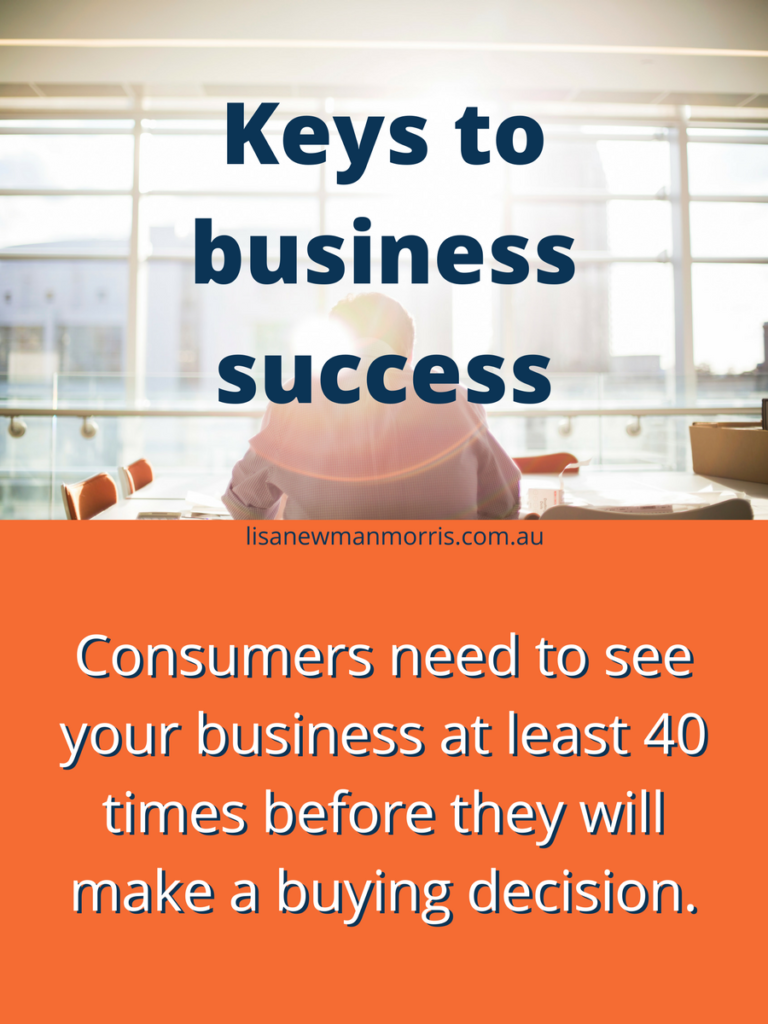Two events, ten years and why business has changed forever
In the last decade, we have had two major, once in a generation, advancements in technology, which have completely changed the way people communicate and gather information. As a result, business has changed forever.
As a business owner, you must understand how these changes have made a difference to the way customers buy and what you need to do as a business to survive in 2017 and beyond.
These two critical events altered the way businesses must communicate to consumers. It’s critical businesses are equipped with the knowledge and the strategies to adapt to these changes. Because of these two massive changes, businesses now find it harder than ever to communicate their message and stand out from the crowd.
For small business owners who have been in business prior to these changes, myself included, the impact has been noticeable. It’s harder to get a new startup off the ground and harder to sustain a profitable business.
So what were these TWO technological advancements which have influenced business so heavily over the past decade?
- Smart phones were invented
- Social media became a business tool
It’s staggering to think only 10 years ago, there was no such thing as a smartphone and social media didn’t exist. These two advancements in technology have completely changed the way people communicate, gather information and do business. The concept of not being able to instantly access the internet to find information at any time, in any place is so foreign. It’s almost inconceivable to think how we achieved anything before.
These events have meant huge challenges for businesses to be noticed by potential customers. It’s meant increased difficulty in getting leads and successfully converting those leads into customers. But there is good news. Being informed about how these changes have impacted consumer behaviour and being prepared to adapt your business systems is key.
If you’re a business owner, still trying to apply pre-mobile revolution strategies to your business operations, especially your marketing strategies, success may be eluding you. Changes in conditions require a change in tactic. As conditions change, your approach must also adapt accordingly.
Two, once in a generation advancements in technology, have completely changed the way people communicate, gather information and do business. Share on X
Adapt or fail
The same way technology in sport has moved the bar in terms of limits on human performance, as a business owner you must adapt your strategies and embrace the current climate if you want to remain competitive. An Olympic athlete wanting to be competitive in 2017, can’t rely on training strategies from past decades.
If an athlete turned up at the Olympics having completed a training regime from the 1980’s, they’d quickly be relegated to last place. In fact, the reality is, they wouldn’t even qualify to participate on the world stage against the highly tuned and technologically advanced athletes of today.
Take the Men’s 100 metre swimming world records from history as an example. In 1972, Mark Spitz set a new World Record at the Munich Olympic Games in a time of 51.22 seconds. In 2009, Brazilian Cesar Cielo set the current standing record of 46.91 seconds (source – FINA).
Mark Spitz, one of the most iconic names in swimming history, swimming his best effort ever, would not even make the B qualifying time for the 2016 Olympic Games, let alone the A qualifying time. The Olympic Qualifying time for the A cut for 100m men’s freestyle was 48.99 seconds and the B qualifying time was 50.70 seconds.

This example of how much the sport of swimming has advanced and changed, demonstrates the tactics adopted by the very best in the world just 45 years ago, would not come close to challenging today’s best.
Business is no different.
Mobile has changing everything
According to CCS Insight, by 2019, it’s estimated there will be 2 billion smartphones sold worldwide. In comparison, if current declining trends continue as they have for the past five years, the number of personal computers shipped around the world by 2019 will be only approximately 250 million (source – Garnter).
Our desire for living life on the run and having mobile access to unlimited information at our fingertips is almost beyond comprehension. As business owners, we have to recognise how much these changes impact the consumer’s ability to decide what they will buy and where they will buy it from.
Small business must recognise how these changes impact the consumer’s ability to decide what they will buy and where they will buy it from. Share on X

As a business, you must recognise that every other business is in the same boat. Every other business is up against this technological revolution. Every business is trying to stand out and be seen.
As a small business, not only are you battling advancements in technology and change in consumer buying behaviour, you are competing against every other business who is fighting the same fight.
What does this mean for your business?
The mobile revolution has had a major impact on how consumers make purchasing choices. With so much readily available information at their fingertips, and more marketing messages trying to grab their attention, consumers need to gather more information from more sources before they make a buying choice.
What does this mean for your business?
There are two strategic changes your business must consider:
- You need to have more touch points available for consumers to notice you
- You need to allow consumers more time to buy
In a nutshell, business in 2017 is about patience!

The more information available for people to consume, the more information they need to be able to make a decision. Have you ever had to make a decision between two items? I imagine you would look at the pros and cons of each choice, and then you’d select your favourite or the one that serves your need the best. The decision would be relatively easy.
Now try and make a decision between 20 items. You’re confusion increases. You’re anxious and paralysed by indecision. You go back and forth weighing up which is the right choice. It’s likely you might not be able to make a decision at all.
This phenomenon of analysis paralysis results in consumers needing to gather exponentially more pieces of information from your business before they decide to buy from you. Their confusion from information overload may even mean, regardless of how good your product is, or how value packed your service, they don’t buy from you at all.
Let’s look in more detail at the two strategic changes your business must embrace:
1. More touch points
When I started my previous local service based business in 2003, we used to talk about customers needing to see you three times before they’d buy. Then a few years later that number changed to seven. I still sometimes see these statistics quoted today but conditions are changing so fast, and the mobile revolution is advancing at such a rate, we can no longer rely on statistics from a decade ago.
Ten years ago, your small business could run a single campaign such as a newspaper advertisement or a radio campaign and expect to get leads flooding through their door. That simply doesn’t work any more. It’s not enough.
It’s not enough to advertise once and expect to gain a customer. This is how business used to work, before the mobile revolution, but not any more.
It’s not enough to advertise yesterday, and expect a customer to buy today. If you want a customer today, you have to be in front of that customer, today! A well thought out and well executed marketing campaign executed three months ago, is not going to be effective today, unless there has been continual follow up.
If you’re not in front of the customer providing value, at the moment they are ready to buy, another business will be. The problem is, you will never know when that ‘ready to buy’ moment will be for the customer. With every other business competing for the same customer and having such easy access to speak to that customer at any time, in any location, you have to do more to ensure your business gets noticed.
Related post: Seven reasons why you need to define your ideal client
According to Google:
– in 2009, people needed to consume between 2-3 pieces of information before they made a buying decision
– in 2010, that doubled to 5.3 pieces of information
– in 2011, it doubled again to 10.4
– in 2014, it was estimated to have almost doubled again to 18.2 sources of information
(source – Youtility, Jay Baer).
Access to mobile information is becoming easier, cheaper and more accessible as each year passes. Mobile plans are becoming more competitive. Free WiFi and mobile hot-spots in the community are now commonplace.
If we extrapolate the figures above, we can conservatively estimate that people may need to consume at least 40 pieces of information from your business, before they’ll interact or buy from you!!
Consumers need to see your business at least 40 times before they will make a buying decision. Share on X
Consistency, diversity and specificity in your marketing is so important. To stay fresh in the minds of your ideal customers, you must ensure your business is top of mind the moment your customer is ready to buy.

Quality and quantity
Not only is it necessary to have more points of exposure available for consumers to notice you, your business must provide more value than the competition to stand out from the crowd. Unfortunately, quantity alone will only get you so far.
Think about what you sell. Consider the problem you are solving. If a consumer wanted to know the answer to a specific problem related to your product or service, how easy it is for them, in 2017, to find an answer.
So why should they buy from you?
Value driven marketing, sometimes known as content marketing, is a strategy of providing free, highly valuable, relevant information, solving a specific problem for a targeted customer. By providing helpful information for free, you build trust with the buyer and you establish yourself as an expert in your field.
2. Allowing consumers more time to buy
Patience is not only a virtue, it’s a requirement when it comes to business. You now know it takes more points of exposure to grab a potential customer’s attention but it also takes more time for that buyer to complete the transaction.
There are numerous sales statistics stating 80 percent of sales are made on the fifth to twelfth follow up. As a business operator, getting a customer’s attention via your marketing efforts is not the end of the process. In fact it’s just the beginning. It’s your job to follow up your lead and help them through the buying process. With so many options available to consumers, if you don’t follow up the enquiry, another business will!
A customer will only buy when they know, like and trust you. It takes time to build the relationship between customer and business to the point where a transaction is made.
Once upon a time, this relationship was built at the point of sale. In 2017, the relationship has to be built before the customer even interacts with you and then during the decision making process.
Too many sales people fail to provide a thorough follow up service to help the customer through the buying process.
A customer will seek out information when they have a need. They will only buy when they are ready. These things don’t always happen at the same time. It’s your job as the business owner, to nurture the relationship and help them until they are ready to buy.
Free Download – 7 things a customer needs before they can buy from you
A customer will seek out information when they have a need. They will only buy when they are ready. Share on X

Conclusion
For your business to succeed in 2017 and beyond, a new approach is required. A 2017 strategy requires more consistency, more diversity and more patience than ever before. As consumers seek more information and more value before they make a purchase decision, you need to ensure they are able to find valuable, relevant information from your business and you need to ensure your branding is in front of your potential customer, at the exact moment when they are ready to buy.



This is such an interesting article and it’s so true! I notice it all the time as a consumer and the marketing strategies of businesses have changed so much in the past years.
Yes there certainly is a noticeable change across many platforms!
Yes, there has certainly been an amazing difference in technology over the last ten years. I find it especially interesting that you say people need to see your business 40 times before they’ll buy. I had no idea it was that much. Thank you! (I tweeted that statement.)
Have you ever had cold feet?
Yes it’s a scary statistic isn’t it Shirley. Big brands have known this for years which is why you see them everywhere you turn. For small business it’s a bit tougher because the budget is lower but it just means being smart and savvy to achieve the same result.
I was a store vendor for years – sales support, merchandising – and I’ve seen the business change. People buy the bread and butter – all the high turnover items – online, instead of at the store, and only come in for the purchases where they need the attention of a salesperson.
And sometimes they get all their questions answered – and then look for better prices online right in front of us! And the online sources are cheaper precisely because they don’t have someone spending 20 minutes helping you choose the right model.
And the small stores can’t survive as showrooms with only occasional sales. Lot of people trying to figure out how best to change their business model…
Yes the digital age has certainly made businesses have to up their game. Great service seems to be a thing of the past unfortunately. The good news is that research tells us people are more than willing to be loyal to a business that gives them great service and people are also willing to spend a little more as long as they get great service. Most people don’t buy based on price alone. Businesses just need to realise this!
I have noticed how things have changed for businesses over the years. It seems small business have it rougher where I live.
Many businesses are doing it tougher Sandy because they’re not aware of the need to adapt or don’t know what to do. But on the flip side there are many businesses being highly innovative and booming in today’s market. So you’ve got to ask yourself, why is that and how are they doing it?
I agree that technology has really changed everything. It’s made all the difference in how we consume, purchase, and also distribute. Everything now is online and just a click away. Check out Amazon now buying Whole Foods and being able to distribute and deliver fresh organic foods with just a click. What about McDonald’s also pairing up with Uber now? It’s amazing.
It certainly is Sonyo! Business owners must be innovative and adapt to these types of changes or be left behind.
Digitalization in our days is a topic which is pulsing in Europe high. Jobs are going away and some job groups are not required anymore. Think about that by 2022 in Europe no truck shall hit the road anymore. What will happen to all the truck drivers? cheers Dieter
It’s an interesting time Dieter. Our children and grandchildren are going to be working towards careers and industries which have not been invented yet. It’s so fascinating!